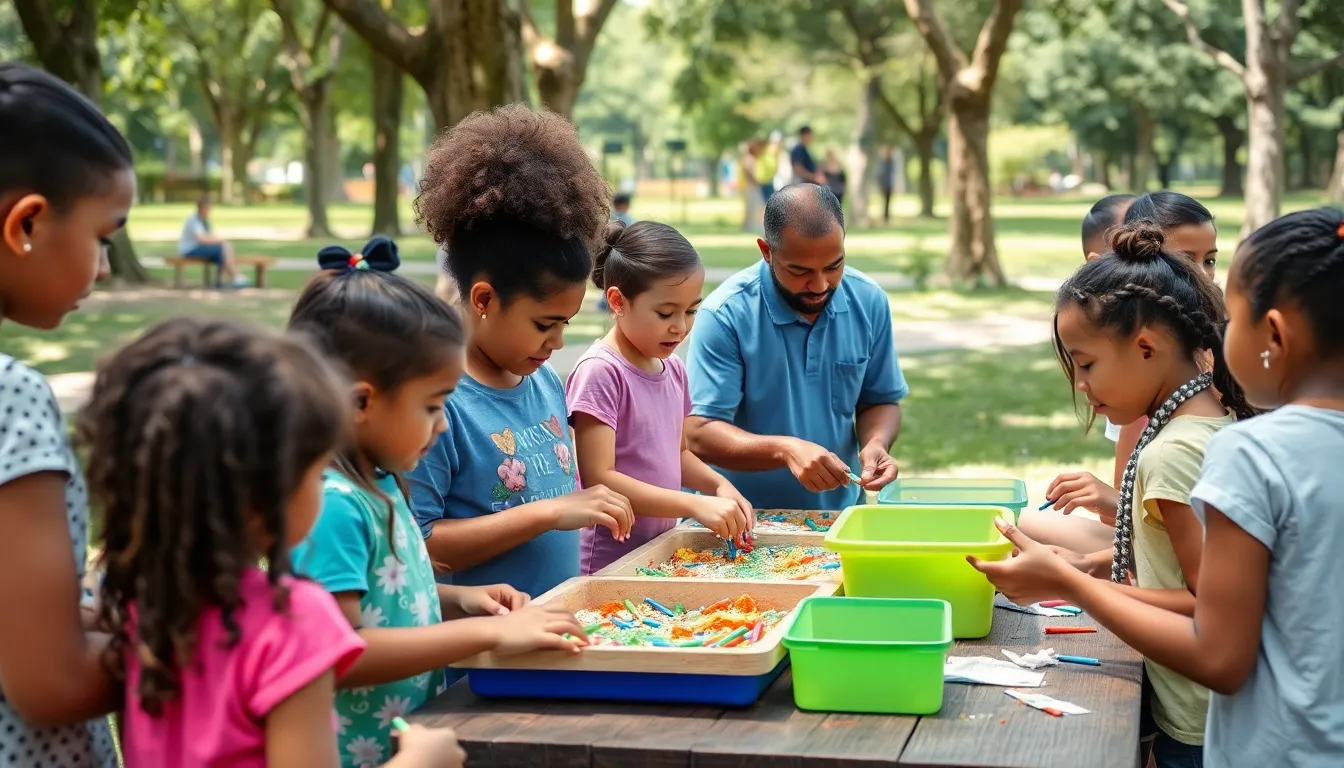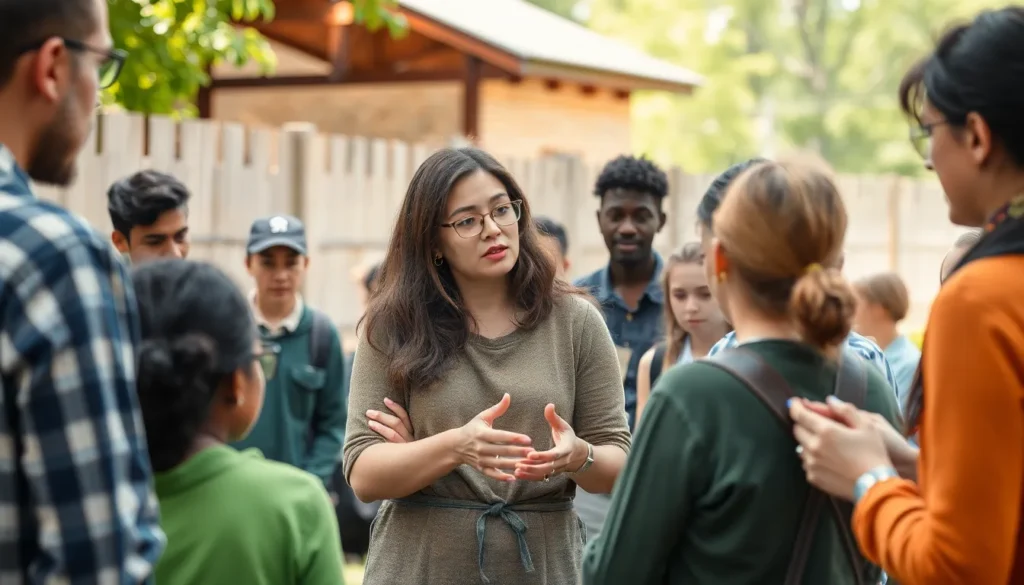Table of Contents
ToggleEducation outreach plays a crucial role in bridging gaps and fostering inclusivity within communities. By extending learning opportunities beyond traditional classrooms, it empowers individuals from diverse backgrounds to access valuable resources and support. This initiative not only enhances educational equity but also cultivates a sense of belonging and engagement among participants.
As society evolves, the demand for innovative outreach strategies grows. Organizations and educational institutions are increasingly recognizing the importance of tailored programs that address specific community needs. Through partnerships and collaborative efforts, they can create impactful experiences that inspire lifelong learning and personal growth. Understanding the significance of education outreach is essential for nurturing a well-informed and skilled population ready to tackle the challenges of tomorrow.
Overview of Education Outreach
Education outreach encompasses initiatives aimed at extending educational opportunities to underserved and marginalized populations. These initiatives strive to eliminate barriers to access, ensuring individuals receive valuable learning experiences. Programs often target youth in impoverished areas, adult learners seeking job skills, and families aiming for higher education.
Education outreach employs diverse methods, including workshops, tutoring sessions, mentorship programs, and community events. Partnerships with local organizations, schools, and businesses enhance the effectiveness and reach of these programs. Through collaboration, education outreach addresses specific community needs, tailoring strategies that resonate with participants.
Measurement of success in education outreach relies on various metrics. Data collection might include enrollment figures, participant feedback, and academic achievement. By analyzing this information, organizations can refine approaches, adapting to changing community dynamics and improving overall impact.
Innovative technologies also play a role in education outreach. Online platforms, mobile applications, and virtual classrooms expand access to resources and learning opportunities. These tools enable remote participation, offering flexibility that accommodates diverse schedules and lifestyles.
Education outreach significantly contributes to enhancing educational equity through targeted strategies, community collaboration, and the integration of technology.
Importance of Education Outreach

Education outreach plays a crucial role in fostering inclusivity and bridging gaps within communities. It empowers diverse individuals through enhanced educational opportunities while addressing the unique needs of each community.
Benefits for Communities
- Enhanced Access: Education outreach increases access to learning opportunities for individuals in underserved areas by providing tailored programs.
- Skill Development: Communities gain strong skill sets through training initiatives that directly respond to local workforce needs.
- Community Engagement: Outreach efforts encourage active community participation, promoting collaboration between schools, organizations, and families.
- Increased Awareness: Outreach raises awareness about educational resources available, ensuring families are informed about opportunities for their children and themselves.
- Support Networks: Programs create support networks that foster connections among participants, enhancing social capital within communities.
Impact on Educational Equity
- Bridging Gaps: Education outreach targets marginalized populations, narrowing the achievement gap through access to resources and support systems.
- Tailored Programs: Initiatives customized for specific community needs promote equitable opportunities, addressing barriers to education faced by various demographic groups.
- Diverse Learning Modalities: Outreach programs incorporate different learning modalities, ensuring all individuals, regardless of background, can engage effectively.
- Empowerment: Education outreach empowers students and families by providing the tools and knowledge necessary to pursue academic and career goals.
- Long-term Benefits: The positive impact of education outreach extends beyond immediate access, fostering a culture of lifelong learning and contributing to overall community growth.
Strategies for Effective Education Outreach
Effective education outreach strategies focus on building strong community connections and leveraging local resources. These approaches enhance access to education and foster lasting relationships.
Community Engagement Techniques
Engaging the community involves multiple approaches:
- Workshops: Facilitate hands-on learning experiences that allow individuals to explore new subjects and skills.
- Events: Host community events, such as fairs or open houses, to showcase educational resources and opportunities.
- Feedback forums: Create avenues for community input to identify needs and refine outreach efforts based on collective experiences.
- Social media campaigns: Use digital platforms to reach a wider audience, share success stories, and promote educational initiatives.
These techniques foster active participation and strengthen community bonds while ensuring outreach remains relevant to local needs.
Collaborations with Local Organizations
Collaborating with local organizations maximizes resources and effectiveness. Key strategies include:
- Partnerships: Engage schools, nonprofits, and businesses to pool resources and expand program reach.
- Shared initiatives: Develop joint programs that address community-specific educational challenges, such as literacy programs or vocational training.
- Resource sharing: Utilize facilities and equipment from local entities to reduce costs and enhance program delivery.
- Cross-promotion: Leverage each organization’s networks to promote educational initiatives, increasing visibility and participation.
These collaborations create a comprehensive support system, empowering individuals through access to diverse educational opportunities.
Challenges in Education Outreach
Education outreach faces significant challenges that can hinder its effectiveness in promoting inclusivity and accessibility. Understanding these obstacles allows organizations to develop targeted strategies for improvement.
Resource Limitations
Education outreach often struggles with resource limitations, including funding, personnel, and materials. Nonprofit organizations regularly encounter tight budgets, which restrict program development and implementation. According to a report by the National Center for Education Statistics, only 14% of community-based educational programs receive adequate funding. Inadequate staffing leads to reduced program quality, making it challenging to offer comprehensive support to underserved populations. Likewise, the lack of educational materials, such as books and technology, limits the effectiveness of outreach initiatives. Organizations must prioritize resource allocation and seek partnerships to enhance their outreach capabilities.
Overcoming Resistance to Change
Overcoming resistance to change represents another challenge in education outreach. Stakeholders, including educators, community leaders, and potential participants, may be hesitant to adopt new methods or programs. A study by the American Educational Research Association indicates that 60% of educators express skepticism toward innovative teaching techniques. Addressing this resistance requires transparent communication about the benefits of outreach initiatives, demonstrating successful case studies, and involving stakeholders in the planning process. Engaging communities in the development of programs fosters ownership and eases skepticism, empowering individuals to embrace change and participate in educational opportunities.
Future Trends in Education Outreach
Education outreach will increasingly rely on innovative strategies that adapt to shifting societal needs. As technology evolves, it’s crucial to harness its potential to extend educational opportunities and foster inclusivity.
Technology Integration
Technology integration in education outreach will enhance engagement and improve access. Online learning platforms will provide flexible, self-paced learning opportunities. Virtual reality (VR) and augmented reality (AR) will create immersive educational experiences, allowing participants to explore complex concepts interactively. Mobile applications will facilitate easy access to resources, enabling users to learn anytime, anywhere. Data analytics will help organizations track progress and personalize learning experiences. As technology continues to advance, outreach programs can become more effective and adaptive, ultimately enriching the educational landscape.
Expanding Access to Diverse Populations
Expanding access to diverse populations requires targeted strategies that consider the unique needs of communities. Outreach programs will develop partnerships with local organizations to reach underserved groups, focusing on both youth and adults. Multilingual resources will accommodate non-English speakers, ensuring inclusivity. Culturally relevant curriculum development will engage participants and reflect their backgrounds. Support services, such as childcare and transportation assistance, will eliminate barriers for families. These efforts will create equal opportunities for all individuals, fostering an environment where education thrives across diverse demographics.
Education outreach is vital for fostering inclusivity and ensuring equitable access to learning opportunities. By addressing the unique needs of diverse communities and leveraging partnerships, organizations can create impactful educational experiences that resonate with individuals from all backgrounds.
As innovative strategies emerge, the integration of technology and community engagement will continue to play a crucial role in overcoming barriers and enhancing participation. The ongoing commitment to education outreach not only empowers individuals but also strengthens communities, paving the way for a brighter future.
Through collective efforts, education can truly become a catalyst for change, driving social mobility and enriching lives across generations.







